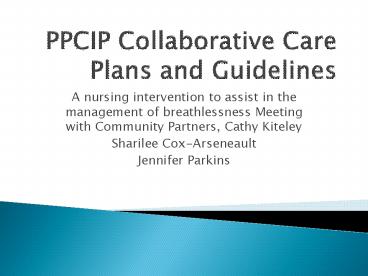PPCIP Collaborative Care Plans and Guidelines - PowerPoint PPT Presentation
1 / 19
Title:
PPCIP Collaborative Care Plans and Guidelines
Description:
A nursing intervention to assist in the management of breathlessness Meeting ... Registered Nurses Association of Ontario. ( 2002) ... – PowerPoint PPT presentation
Number of Views:130
Avg rating:3.0/5.0
Title: PPCIP Collaborative Care Plans and Guidelines
1
PPCIP Collaborative Care Plans and Guidelines
- A nursing intervention to assist in the
management of breathlessness Meeting with
Community Partners, Cathy Kiteley - Sharilee Cox-Arseneault
- Jennifer Parkins
2
Overview
- Welcome and introductions
- Identification of the project
- Community engagement
- Review of dyspnea
- The nuts and bolts of the intervention
- Role play
- Moving the intervention into practice
- evaluation
3
Welcome and warm up
4
Identification of the project
- Community nurse led breathlessness intervention
- In collaboration with the dyspnea management
collaborative care plan as part of the Provincial
Palliative Care Integration Project (PPCIP) - Endorsed by LHIN 56 PPCIP Steering Committee
5
The Nuts and Bolts of the Project
- Best evidence
- Conceptual approach
- Proposed intervention
- Planned education
- Evaluation
6
Context
- Lung cancer is the most frequent diagnosed cancer
overall in Ontario (Canadian Cancer Society,
2007) - Dyspnea common symptom for individuals with
metastatic disease (breast, colon, prostate) - Cancer Care Ontario and PPCIP have identified
dyspnea as a priority symptom
7
Context
- Nurses have good knowledge skill and judgment in
symptom management. This project will articulate
many of the interventions nurses are already
using in their clinical practice and will
incorporate best evidence.
8
Best Evidence
- Findings from chart review on 183 cancer
patients first visit attending Credit Valley
Hospital Palliative Care Clinic (C Kiteley, A
Kurtz-Melo, 2006)
9
- One years worth of data from the palliative care
clinic analyzed. - Here is what we found!!
10
PPS Comparison on First Visit
LUNG
NON-LUNG
Average PPS Score 61
Average PPS Score 57
Total with PPS 60 and below Lung 81
Non-Lung 65
Statistically significant difference using
chi-square analysis
11
Symptom Profile (ESAS) Comparison on First Visit
LUNG
Avg. Symptoms 6.4
77 had 6 or more symptoms rated 3 or greater
NON-LUNG
Avg. Symptoms 5.6
59 had 6 or more symptoms rated 3 or greater
Statistically significant difference using
chi-square analysis
12
Comparison of Average Severity of ESAS Symptoms
on First Visit
Statistically significant difference using t
test Marginal significance
13
Best Evidence
- Two Randomized controlled studies are the
foundation of the proposed nursing intervention - Studies by Corner et al 1996 and Bredin et al
1999 - Improved dyspnea rating
- Improved function
- Improved QOL
14
Best Evidence
- Another study by Hately et al (2003) replicated
the nurse interventions in previous studies in a
physio led clinic for breathlessness and found
similar results
15
Conceptualization
- Conceptualization A Parallel Model of Care
Bio-medical model Pathophysiology Isolate
cause Intervene Cure/remove sensation Therapeutic
Relationship Active vs passive Controlling
exclusive
A Parallel model Mind body Meaning Symptom
redefined as problem Therapeutic
relationship Partnership, reciprocity, mutual
inquiry
16
Proposed Intervention
- For adult patients with lung cancer experiencing
breathlessness receiving community home nursing - Detailed assessment of breathlessness
- Advice/support on ways to manage
- Therapeutic relationship exploring meaning
- Training on breathing exercises and relaxation
- Goal setting
- Early recognition of problems warranting
pharmacological or medical intervention
17
Evaluation
- Focus group to evaluate nurses experience with
the intervention - Aims of evaluation will be
- Overall satisfaction and confidence in using
intervention - Evaluation of barriers or weaknesses with the
program - Perceived commitment by nurses
- Documentation challenges/issues
18
References
- Bredin, M., Corner, J., Krishnasamy, M., Plant,
H., Bailey, C., AHern, R. - (1999). Multicentre randomised controlled trial
of nursing intervention for breathlessness in
patients with lung cancer. BMJ, 318, 901-903. - Corner, J., Plant, H., A Hern, R., Bailey, C.
(1996). Non-pharmacological intervention for
breathlessness in lung cancer. Palliative
Medicine, 10, 299-305. - Hately, J., Laurence, V., Scott, A., Baker, R.,
Thomas, P. (2003). Breathlessness clinics within
specialist palliative care settings can improve
the quality of life and functional capacity of
patients with lung cancer. Palliative Medicine,
17, 410-417. - Kitson, A., Harvey, G., McCormack, B. (1998).
Enabling the implementation of evidence based
practice a conceptual framework. Quality in
Health Care, 7, 149-158.
19
References
- Logan, J., Graham, I. (1998). Toward a
comprehensive - Interdisciplinary model of health care research
use. Science - Communication, 20(2), 227-246.
- Registered Nurses Association of Ontario.
(2002). Toolkit Implementation of clinical
practice guidelines. Toronto, Canada - Registered Nurses Association of Ontario.































